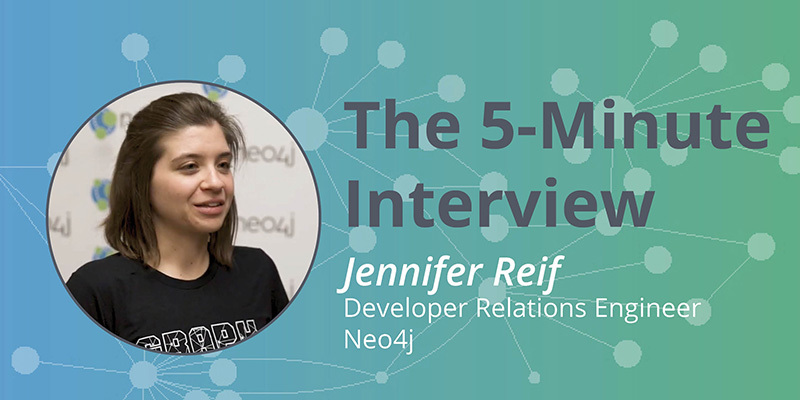Creating Aha Moments for Developers: The 5-Minute Interview with Jennifer Reif, Developer Relations Engineer at Neo4j

Product Marketing Manager, Neo4j
5 min read

“Even something as simple as mapping your IT network, which really makes sense when you look at it as a graph, takes the concept of graph and makes it a little bit more tangible,” said Jennifer Reif, Developer Relations Engineer at Neo4j.
A graph database like Neo4j is different from what most developers have worked with before. It requires a new perspective and thinking outside the box, but builds on what they already know.
In this week’s five-minute interview (conducted at GraphTour DC 2019), Jennifer Reif shares her excitement about spurring aha moments and about the contributions of the Neo4j community.
What are you working on at Neo4j?
I get to work on a lot of the cool integration projects that connect Neo4j and lots of other tools and systems out there.
I recently worked on redesigning the developer guides on our site, giving them a new look and feel as well as trying to update them looking at what our users need, what is missing in their learning process, what information they need to build some of the tools and applications they’re working with.
What are you looking forward to that is coming out in Neo4j?
I’m hoping to work a little bit more with our Spring Data Neo4j project and the reactive capabilities that will go along with that. I’m looking forward to diving in and then, of course, showing other people how to use the reactive capabilities as well.
What is your favorite aspect of Neo4j?
I think there are two. First, there are tons of integrations. Whatever tool you’re working with or system you’re using, there’s probably a connector out there that lets you feed data back and forth between Neo4j and all these other systems and tools.
The other thing is the flexibility of the model and of Cypher itself. It opens up a whole new world that you don’t really get with a lot of other database structures. The flexibility of adapting the data model and looking at how things are related and connected I think is really powerful.
What is your favorite use case for Neo4j?
So I think one of my favorites is medicine and science, looking at how diseases propagate through networks and learning how can we fight them using things like graph algorithms or even just regular Cypher queries.
Or just looking and analyzing the connections between atoms and molecules to try to solve some of the really complex problems out there, including mappings of the brain. I know they’re doing a lot with species and animal bioscience that I think is really interesting.
Even something as simple as mapping your IT network, which really makes sense when you look at it as a graph, really takes the concept of graph and makes it a little bit more tangible.
What is the most interesting part of learning Neo4j?
The toughest thing and probably the coolest thing is when we get users to think outside of the box. Because it’s different from anything they’ve ever done with relational databases or document databases or any other type of NoSQL.
You’re dealing with network science and graph theory. Everybody grasps things a little bit differently and learns slightly differently, so we’re trying to apply graph theory in different ways so that people get that aha moment. I think what’s really rewarding is to finally see it click for somebody. They’ll say, “Oh, I need to use this,” or “I know exactly where to use this now.”
I think that’s probably one of the best things about getting to teach people Neo4j and show developers how to use it.
What advice do you have for someone getting started with Neo4j?
You don’t need to throw out everything you know. I think it’s really just opening up those concepts so they don’t limit you.
You may have boundaries that you’re used to, and this is something that’s totally outside those boundaries. It requires figuring out how you can plug something new into what you already know. It requires being creative and willing to step out and look at something that’s a little bit different.
What is your favorite part of the Neo4j community?
I think it’s the contributions, and we have a lot of them. It’s not just technical projects that are contributed, but also the work of people who write blog posts on their perspectives of learning the technology or working with a particular tool. I think it really helps us see what users really want and are actually using out there.
It also helps us see the things that they struggled with, the things they had trouble using, or finding the connections for. It’s not just the technical projects, but then blog posts and the questions that are asked on our community site. It lets us see where the gaps are as well as the things that are working really well that users love.
What does the future hold for graph technology?
I think graph in general is going to get a whole lot bigger. The world is very connected, and I think it is just going to get smaller as far as all the connections go. People are going to want to relate all this data that seemingly doesn’t relate. If you put it into Neo4j, you’ll see those hidden connections.
So I think in general, graph is going to grow, and artificial intelligence and machine learning are really going to explode. You’re going to find people wanting to build more solutions for that sort of thing, you’re gonna wanna let these processes learn on the fly with graph native learning, and I think you’re gonna see that just continue to improve and get better and better, and technology will move with that too.
Want to share about your Neo4j project in a future 5-Minute Interview? Drop us a line at content@neo4j.com
Show off your graph database skills to the community and employers with the official Neo4j Certification. Click below to get started and you could be done in less than an hour.








